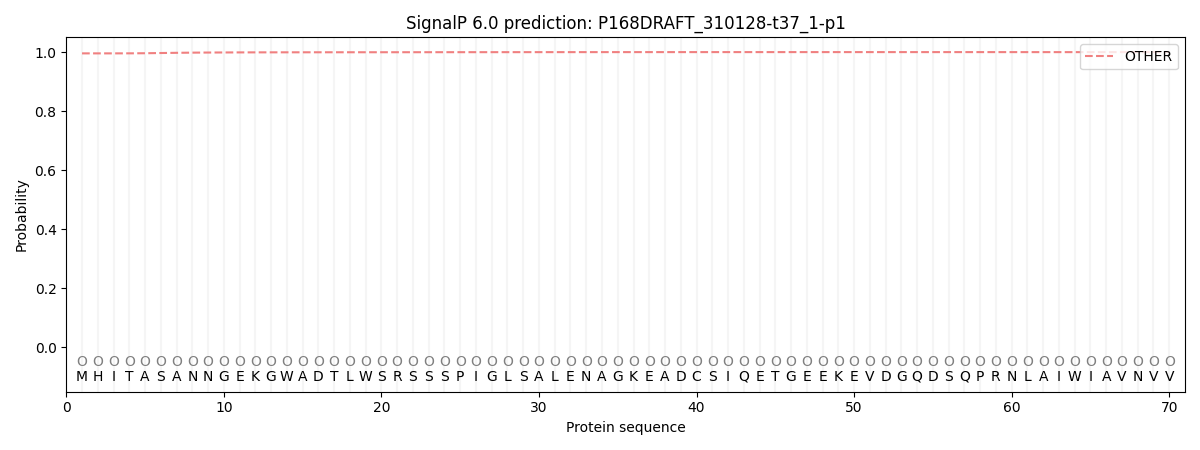You are browsing environment: FUNGIDB
CAZyme Information: P168DRAFT_310128-t37_1-p1
You are here: Home > Sequence: P168DRAFT_310128-t37_1-p1
Basic Information |
Genomic context |
Full Sequence |
Enzyme annotations |
CAZy signature domains |
CDD domains |
CAZyme hits |
PDB hits |
Swiss-Prot hits |
SignalP and Lipop annotations |
TMHMM annotations
Basic Information help
| Species | Aspergillus campestris | |||||||||||
|---|---|---|---|---|---|---|---|---|---|---|---|---|
| Lineage | Ascomycota; Eurotiomycetes; ; Aspergillaceae; Aspergillus; Aspergillus campestris | |||||||||||
| CAZyme ID | P168DRAFT_310128-t37_1-p1 | |||||||||||
| CAZy Family | GH76 | |||||||||||
| CAZyme Description | integral membrane protein | |||||||||||
| CAZyme Property |
|
|||||||||||
| Genome Property |
|
|||||||||||
| Gene Location | ||||||||||||
CAZyme Signature Domains help
| Family | Start | End | Evalue | family coverage |
|---|---|---|---|---|
| GT32 | 431 | 508 | 2.4e-17 | 0.9111111111111111 |
CDD Domains download full data without filtering help
| Cdd ID | Domain | E-Value | qStart | qEnd | sStart | sEnd | Domain Description |
|---|---|---|---|---|---|---|---|
| 226297 | OCH1 | 2.10e-26 | 356 | 604 | 17 | 243 | Mannosyltransferase OCH1 or related enzyme [Cell wall/membrane/envelope biogenesis]. |
| 398274 | Gly_transf_sug | 6.66e-16 | 429 | 514 | 1 | 90 | Glycosyltransferase sugar-binding region containing DXD motif. The DXD motif is a short conserved motif found in many families of glycosyltransferases, which add a range of different sugars to other sugars, phosphates and proteins. DXD-containing glycosyltransferases all use nucleoside diphosphate sugars as donors and require divalent cations, usually manganese. The DXD motif is expected to play a carbohydrate binding role in sugar-nucleoside diphosphate and manganese dependent glycosyltransferases. |
| 307170 | EamA | 3.77e-07 | 215 | 348 | 2 | 133 | EamA-like transporter family. This family includes many hypothetical membrane proteins of unknown function. Many of the proteins contain two copies of the aligned region. The family used to be known as DUF6. Members of this family usually carry 5+5 transmembrane domains, and this domain attempts to model five of these. |
| 223769 | RhaT | 2.60e-06 | 93 | 353 | 37 | 289 | Permease of the drug/metabolite transporter (DMT) superfamily [Carbohydrate transport and metabolism, Amino acid transport and metabolism, General function prediction only]. |
| 129898 | tpt | 0.004 | 143 | 349 | 83 | 291 | Tpt phosphate/phosphoenolpyruvate translocator. The 6-8 TMS Triose-phosphate Transporter (TPT) Family (TC 2.A.7.9)Functionally characterized members of the TPT family are derived from the inner envelope membranes of chloroplasts and nongreen plastids of plants. However,homologues are also present in yeast. Saccharomyces cerevisiae has three functionally uncharacterized TPT paralogues encoded within its genome. Under normal physiologicalconditions, chloroplast TPTs mediate a strict antiport of substrates, frequently exchanging an organic three carbon compound phosphate ester for inorganic phosphate (Pi).Normally, a triose-phosphate, 3-phosphoglycerate, or another phosphorylated C3 compound made in the chloroplast during photosynthesis, exits the organelle into thecytoplasm of the plant cell in exchange for Pi. However, experiments with reconstituted translocator in artificial membranes indicate that transport can also occur by achannel-like uniport mechanism with up to 10-fold higher transport rates. Channel opening may be induced by a membrane potential of large magnitude and/or by high substrateconcentrations. Nongreen plastid and chloroplast carriers, such as those from maize endosperm and root membranes, mediate transport of C3 compounds phosphorylated atcarbon atom 2, particularly phosphenolpyruvate, in exchange for Pi. These are the phosphoenolpyruvate:Pi antiporters (PPT). Glucose-6-P has also been shown to be asubstrate of some plastid translocators (GPT). The three types of proteins (TPT, PPT and GPT) are divergent in sequence as well as substrate specificity, but their substratespecificities overlap. [Hypothetical proteins, Conserved] |
CAZyme Hits help
| Hit ID | E-Value | Query Start | Query End | Hit Start | Hit End |
|---|---|---|---|---|---|
| 2.93e-156 | 350 | 700 | 13 | 362 | |
| 2.93e-156 | 350 | 700 | 13 | 362 | |
| 2.93e-156 | 350 | 700 | 13 | 362 | |
| 4.15e-156 | 381 | 700 | 38 | 362 | |
| 2.81e-145 | 392 | 700 | 58 | 371 |
Swiss-Prot Hits download full data without filtering help
| Hit ID | E-Value | Query Start | Query End | Hit Start | Hit End | Description |
|---|---|---|---|---|---|---|
| 7.90e-26 | 61 | 353 | 14 | 298 | Solute carrier family 35 member E3 OS=Bos taurus OX=9913 GN=SLC35E3 PE=2 SV=1 |
|
| 1.96e-25 | 65 | 353 | 18 | 298 | Solute carrier family 35 member E3 OS=Danio rerio OX=7955 GN=slc35e3 PE=2 SV=1 |
|
| 8.90e-25 | 61 | 353 | 14 | 298 | Solute carrier family 35 member E3 OS=Mus musculus OX=10090 GN=Slc35e3 PE=2 SV=1 |
|
| 1.63e-24 | 61 | 353 | 14 | 298 | Solute carrier family 35 member E3 OS=Homo sapiens OX=9606 GN=SLC35E3 PE=1 SV=1 |
|
| 5.89e-23 | 48 | 351 | 2 | 300 | UDP-rhamnose/UDP-galactose transporter 1 OS=Arabidopsis thaliana OX=3702 GN=URGT1 PE=1 SV=1 |
SignalP and Lipop Annotations help
This protein is predicted as OTHER

| Other | SP_Sec_SPI | CS Position |
|---|---|---|
| 0.996219 | 0.003780 |
TMHMM Annotations download full data without filtering help

| Start | End |
|---|---|
| 277 | 299 |
| 351 | 368 |
| 61 | 83 |
| 88 | 110 |
| 125 | 147 |
| 156 | 178 |
| 216 | 235 |
| 248 | 267 |
